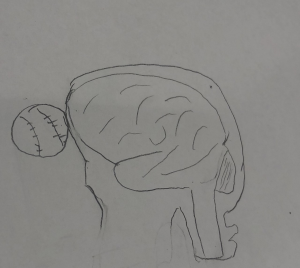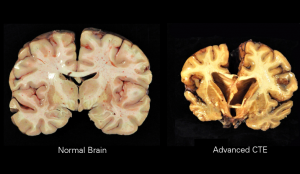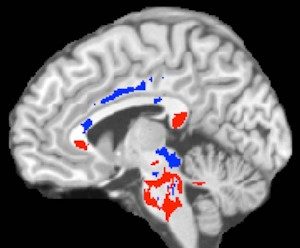
Artstract created by T. Courier
What is a Concussion?
Concussions are a type of traumatic brain injury. In 2014 there were approximately 2.87 million concussions in the United States, but many people fail to receive treatment for concussions. Symptoms include headache, loss of consciousness, ringing in the ears, nausea, slurred speech, and fatigue. These symptoms can last for a few days after the incident to weeks or months later. https://www.mayoclinic.org/diseases-conditions/concussion/symptoms-causes/syc-20355594
Concussions happen when impact to the head causes the brain to forcefully make contact with the skull. This causes a myriad of effects within the brain. The neurons in the brain depolarize and there is a release of excitatory neurotransmitters, causing further depolarization. Ions rush out of the cell and the activity of the enzyme that break ATP into ADP. This causes the mitochondria to go into overdrive in an attempt to restore normal levels of ATP in the cell. Calcium also rushes into the cell and is stored in the mitochondria which makes it more difficult for them to produce ATP, causing a decrease in production. This can lead to apoptosis and a loss of neurons. https://www.ncbi.nlm.nih.gov/pmc/articles/PMC4479139/ The loss of neurons is believed to lead to chronic traumatic encephalopathy which is seen in people who have sustained multiple traumatic brain injuries.
Chronic Traumatic Encephalopathy (CTE)
Traumatic Encephalopathy (CTE)
A diagnosis of CTE can only be made during an autopsy. However, there are some behavioral characteristics associated with CTE. These include difficulty thinking, impulsive behavior, short-term memory loss, emotional instability, substance abuse, and suicidal ideation. Many cases of CTE that have been studied occurred in football players, boxers, or military personnel who were exposed to IEDs. CTE occurs in a relatively slow progression and signs can begin to appear years after the trauma. Scientists do not currently know why some people with similar histories of head trauma develop CTE and others do not. The photo above shows the contrast between a healthy brain and the degeneration that found in the brain of someone with CTE. https://www.mayoclinic.org/diseases-conditions/chronic-traumatic-encephalopathy/symptoms-causes/syc-20370921
Diagnosis of Concussion
Concussion diagnoses typical ly rely on neurological and cognitive testing. A neurological test involves tests of vision, hearing, and balance for any deficits that may have been caused by brain trauma. Cognitive tests typically involve tests of memory and concentration that are typically impaired by a concussion. https://www.mayoclinic.org/diseases-conditions/concussion/diagnosis-treatment/drc-20355600 Brain imaging can be used for cases where severe trauma has occurred to assess the level of damage. Two methods that can be used are functional Magnetic Resonance Imaging (fMRI) and Diffusion Tensor Imaging (DTI). fMRI can help detect areas in the brain that have been damaged by concussion and the extent of that damage. https://www.ncbi.nlm.nih.gov/pmc/articles/PMC3995073/ One effect of concussions is damage to axons. DTI can determine where the axonal damage has occurred through abnormal levels of diffusion of water throughout the brain. https://www.mdedge.com/neurology/article/76185/traumatic-brain-injury/dti-may-detect-axonal-injury-after-sports-related The image is a simplified version of a DTI scan. The areas in red indicate where there has been damage to the axons and the areas in blue indicate where diffusion levels are higher than normal which suggests those areas are compensating for the damage. https://medicalxpress.com/news/2016-06-concussion-outcome-advanced-imaging.html
ly rely on neurological and cognitive testing. A neurological test involves tests of vision, hearing, and balance for any deficits that may have been caused by brain trauma. Cognitive tests typically involve tests of memory and concentration that are typically impaired by a concussion. https://www.mayoclinic.org/diseases-conditions/concussion/diagnosis-treatment/drc-20355600 Brain imaging can be used for cases where severe trauma has occurred to assess the level of damage. Two methods that can be used are functional Magnetic Resonance Imaging (fMRI) and Diffusion Tensor Imaging (DTI). fMRI can help detect areas in the brain that have been damaged by concussion and the extent of that damage. https://www.ncbi.nlm.nih.gov/pmc/articles/PMC3995073/ One effect of concussions is damage to axons. DTI can determine where the axonal damage has occurred through abnormal levels of diffusion of water throughout the brain. https://www.mdedge.com/neurology/article/76185/traumatic-brain-injury/dti-may-detect-axonal-injury-after-sports-related The image is a simplified version of a DTI scan. The areas in red indicate where there has been damage to the axons and the areas in blue indicate where diffusion levels are higher than normal which suggests those areas are compensating for the damage. https://medicalxpress.com/news/2016-06-concussion-outcome-advanced-imaging.html
Prevention of Concussion
The detrimental effects of concussion have led to efforts to prevent concussions. One arena where many prevention efforts have been focused is on athletics. Improvements have been made to helmets to help them cushion the head from blows. Another important area has been a focus on delaying when children are allowed to start using increasingly violent maneuvers in athletics. The age when kids can start tackle football or when soccer players can head a ball has been pushed later in an effort to delay concussion injuries. Another focus has been on proper training for these maneuvers. Serious injuries often happen when a maneuver is done incorrectly and teaching kids when and how to use them correctly can help lessen injuries without changing the sport.